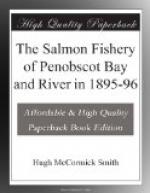Salmon weir, Penobscot. Leader of stakes interwoven with brush, 175 yards long. “Great pond” brush, 42 feet long. “Middle pond” and “back pond,” netting with board floor, each 10 feet long. Outer entrance, 16 feet wide; middle, 2 feet; inner, 1 foot. Value, $75.
x
x x
x x
x x
x / \ x
x/ \x
| |
| |
| |
| / \ |
|/ \|
x x
x x
x x
x x
x x
x x
x x
x x
x x
x x
x | x
x x | x x
x | x
|
|
|
|
|
|
|
|
| | | | | ——+——
Salmon weir, Bucksport. Leader, brush, 4 to 8 rods long. Middle pond, 40 feet long, 8-foot entrance; inner side, brush; outer side, twine. Pockets, twine, 10 feet long, 10-inch entrances, wooden floor. Value, $25. Some weirs have only one (upstream) pocket.
x x
x x
x x
x x x x x x
x xx xx x
x
x
x x x | x x
x x x x | x x x
x x | x
x | x
|xx
|
|
|
|
|
|
|
|
|
|
|
|
|
| | | | | ——+——
“Hook weir,” Orland. A brush hook, about 50 feet long and extending down stream, is built on some of the weirs. It serves the purpose of leading the fish into the net. Value, $35.
+-------+ | | | | | | | x x | __ |x x| ( \ x x \ \ x x \ x x \ x x \ x x \ x x \ x x \ x x \ x x \x x x | x x x | x x x | x | | | | | | | |
| | | | | | | | ——+——
The salmon fishery of the Penobscot basin is carried on with practically a single type of apparatus, namely, the brush weir. In most parts of the region this trap is used in the same form that it had in the primitive days of the fishery, but in some sections the weir has undergone evolution into a combination brush and twine trap, and in places into a trap made wholly of netting.
Some of the types of salmon nets used in this region are illustrated and described by the accompanying figures. In addition to these, which are wholly or partly of brush, a common apparatus is the floating trap, constructed entirely of twine, such as is now generally employed in the New England States. This is the only salmon net in use at Islesboro and in some other sections. The local and individual variations in the form of the nets depend on the topography of the bottom and shore and the habits of the salmon, and are the result of long experience.




